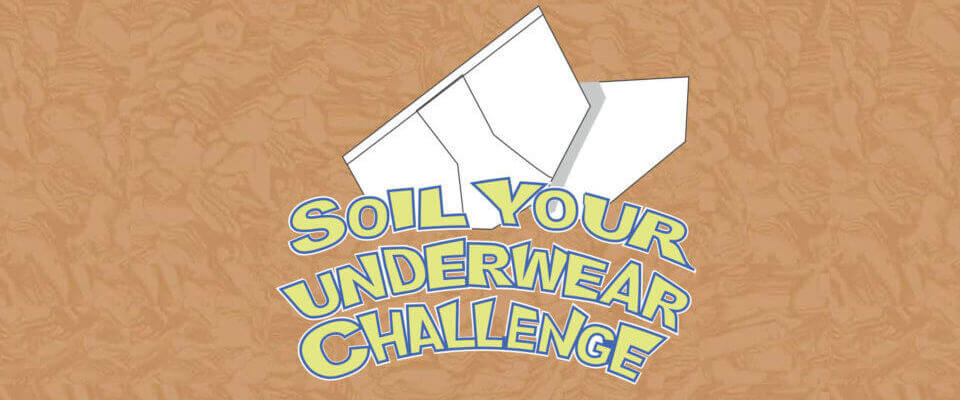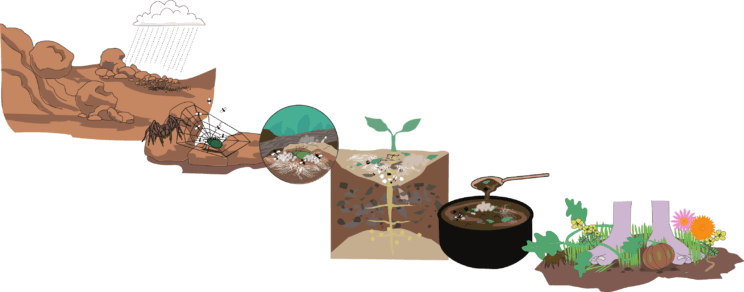Sing With Us
The soil is alive!
ACTIVITY DESCRIPTION
This sing-along guides you through the 5 factors of soil formation: parent material, relief, climate, organisms, and time.
A rock represents a soil’s parent material. Imagine a rock falling off a bluff to the ground below, where it begins to break into smaller particles.
Parent Material
The original “parent” materials of soils come from raw rock crumbling apart, sediment deposited by rivers, and even loose debris from urban renewal projects. As these materials weather away they release various-sized particles. Parent material determines a soil’s texture, meaning its proportions of sand, silt, and clay. Clay is very sticky, whereas sand is very gritty. The magnetic-like properties of these particles affect soil nutrients’ storage capacities: sand holds less nutrients and clay holds more.
What does your soil feel like? Is it sticky or more gritty?
As landscapes change, slopes begin to form. This is called relief, and it impacts how sediments and water move across the Earth’s surface.
Relief
The amount of slope—or “relief”—of hillsides impacts how soils develop. Water will pool in depressions, while soils on the shoulders of hillslopes can be bone dry. Since water is usually the driving force in organic matter accumulation, consider how topographic relief and soil water together can affect soil formation.
Will rainfall cause soil erosion in your backyard?
Warm spring and summer rainstorms are major climate drivers in the mineral weathering of rocks.
Climate
The amount of rainfall determines what plants will grow and how the soils will erode. Soils in an Arizona desert receive a lot less rainfall than soils in Illinois or Missouri. Temperature and seasonal variations regulate the life in soil. In the Mississippi River Valley, frigid winters restrict specific plant, insect, and microbe populations— but summers there are so hot and humid that a lot of insects and plants flourish like they do in tropical rainforests.
How will your soil look in 100 years if your climate changes?
Living organisms bring soil formation to life! Imagine: a spider comes along and spins its web in the cracks of an eroding rock. What happens when insects get trapped? “Their bodies decompose and attract someone new!” Next come fungi. Many fungi are saprophytic: they “eat” decaying matter like rotting flies or even your buried underwear.
Organisms
The metabolically-active soil “creatures”— like insects, fungi, and bacteria—are the perpetual force behind soil formation. The speed at which these creatures eat is dependent on soil “atmospheres,” or the amount of gas present in the soil. When water floods a soil the composition of the gases (i.e., oxygen) change. For example, the longer water sits in soil pores the more oxygen disappears.
Some creatures, like anaerobic bacteria, will only “eat” when oxygen levels are very low. Then there are the oxygen-loving aerobic bacteria, which are likely all over your garden soil.
What is the smallest organism you can see living in your soils?
The scale of time is an important variable in how the soil appears today: “For thousands of years it continues to brew.”
Time
Soil horizons tell us the story of how a soil formed. To picture how a soil develops, we have to think past the life expectancy of an average human. Soil life history is classified in many time-frames, from decades to millennia. A mature soil is generally described in terms of the number and types of developed horizons within the profile.
How old is your soil?
The Soil is Alive Lyrics
A rock falls down and crumbles apart.
The soil is alive. The soil is alive.
A rainstorm comes and the breakdown starts.
The soil is alive. The soil is alive.
A spider comes along and makes its home.
It spins an evil web and waits alone.
A beetle gets caught in a web of flies.
They try to escape but no one survives.
The soil is alive.
Their bodies decompose and attract someone new.
The soil is alive. The soil is alive.
A fungus comes along and knows what to do.
The soil is alive. The soil is alive.
It turns the dead flies into food for plants.
Yummy yummy yummy nutrients.
The plants grow old and they start to rot.
They break down with the bugs and rocks.
The soil is alive.
It all stirs together in a dirty stew.
The soil is alive. The soil is alive.
For thousands of years it continues to brew.
The soil is alive. The soil is alive.
And to this day it still grows.
There’s one last thing that you should know.
The soil that lives beneath our feet gives life to you and me.
The soil is alive. The soil is alive.
The soil is ALIVE.










